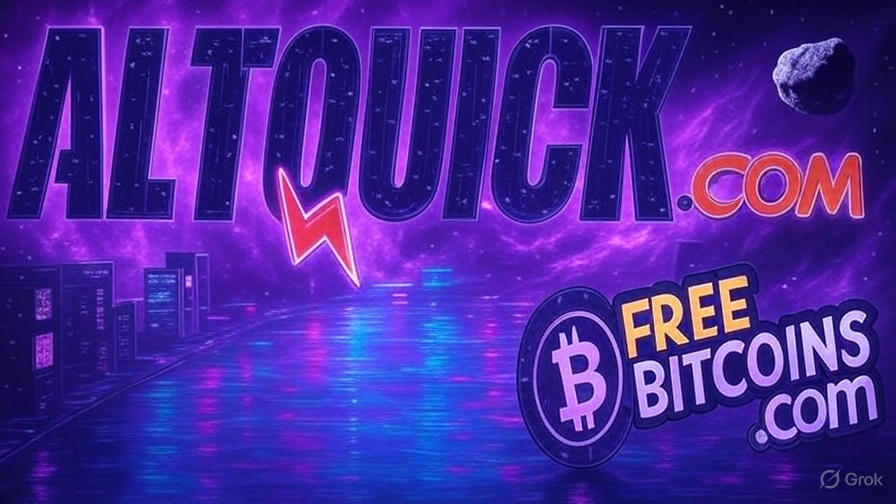The Last of the Old Guard: AltQuick’s Closure Marks the End of Community-Driven Crypto
When the last small exchange closes its doors, something irreplaceable disappears from cryptocurrency
A Quiet Goodbye to Bitcoin’s Experimental Era
On October 1, 2025, at 11:01 PM, a small message appeared in a Discord server that few people outside a dedicated community of altcoin traders would ever see. Steven Steiner—known for over a decade in Bitcoin circles as BayAreaCoins—announced the closure of AltQuick.com, a cryptocurrency exchange that traced its roots back to 2010, when Bitcoin traded for 25 cents.
“It was indeed not a simple find, I’ve chosen to close the website. Please cancel orders and withdraw your coins as soon as possible. Aiming for a final date of Jan 1, 2026 @everyone”
No major crypto news site would cover it. No price would crash. The broader market wouldn’t notice. But for those who remembered when cryptocurrency was about experimentation rather than exploitation, when exchanges were run by individuals who believed in the technology rather than venture capitalists chasing unicorn valuations, this quiet announcement marked something significant: the end of another chapter in crypto’s increasingly corporatized history.
AltQuick wasn’t just an exchange. It was a relic—in the best sense—of crypto’s idealistic origins. A place where you could trade Clamcoin, Namecoin, Gapcoin, and Mazacoin. Where the only Bitcoin Testnet exchange in the world operated. Where no KYC was required because the operators believed cryptocurrency meant freedom from financial surveillance. Where two people—Steven Steiner and Scott Llewellyn—ran everything themselves, maintaining relationships with their small community of users who weren’t customers so much as fellow travelers in the crypto experiment.
When AltQuick closes on January 1, 2026, it won’t just be one exchange shutting down. It will be another piece of Bitcoin’s original vision—decentralized, community-driven, experimental—disappearing into history, replaced by regulated, compliance-heavy platforms that look increasingly like the traditional financial institutions cryptocurrency was supposed to replace.
Six Hours That Changed Everything
The collapse happened faster than anyone expected, even Steven himself. Just hours before the shutdown announcement, everything seemed normal. Discord chatter about Bitcoin testnet trades. Market discussions. The usual banter of a small but dedicated trading community. Steven was actively engaged, welcoming new users, discussing improvements to the site.
Then, at 5:22 PM on October 1st, the first crack appeared:
“Ya back end books look weird,” Steven posted. “Rescanning wallets to make sure no accounting errors. On my way home now.”
The problem: a hard drive had crashed days earlier. When Steven checked the books, he discovered accounts showing users held more cryptocurrency than the exchange actually possessed on the blockchain. Not much, he noted, but “any is a problem.”
“Gotta pause in case it is growing,” he wrote. “Praying it is simple or even just the rescan. Better safe than sorry.”
Six hours later, after investigating the extent of the discrepancy, Steven made his decision. The exchange would close. Not tomorrow, not next week—it was closing now. Trading halted immediately. Users had three months to withdraw their funds.
When users asked what happened, Steven was direct: “No LE issues at all, we’ve never been contacted by them. We had a financial discrepancy, I want to make sure everyone gets their coins out safely and then establish wtf happened firmly.”
No invented story about hackers. No convenient regulatory excuse. No mysterious technical problems that couldn’t be explained. Just: the accounting is wrong, I don’t know why yet, but I’m not going to risk your money while I figure it out.
The Graveyard of Crypto Exchanges: Why This Closure Is Different
To understand why AltQuick’s transparent shutdown represents something rare—perhaps even extinct—in cryptocurrency, you need to understand the graveyard of exchanges that came before it.
A Timeline of Failure and Fraud:
- 2013 – Inputs.io: Claimed hack of 4,100 BTC, suspected inside job, funds never recovered
- 2014 – Mt. Gox: 850,000 BTC lost, CEO arrested, users still seeking compensation over a decade later
- 2015 – Coinwallet.co: Vanished overnight with user funds, classic exit scam
- 2016 – Cryptsy: Operated for 2 years while insolvent, CEO fled to China with funds
- 2016 – Mintpal/Moolah: Systematically looted by convicted fraudster Ryan Kennedy
- 2016 – Camp BX: Cited vague regulatory issues, took years to process final withdrawals
- 2019 – QuadrigaCX: CEO allegedly died with only passwords, $190M lost
- 2019 – Bleutrade: Disappeared without explanation, suspected exit scam
- 2022 – FTX: $8+ billion fraud, Sam Bankman-Fried sentenced to 25 years
Mt. Gox defined how exchange failures would be remembered. Once handling 70% of all Bitcoin transactions, it collapsed in February 2014 after losing 850,000 BTC. CEO Mark Karpeles gave press conferences, claimed technical issues, blamed hackers, but investigations revealed years of mismanagement and missing funds. Users are still fighting for compensation. The closure spawned bankruptcy proceedings, arrests, and a legal saga that continues eleven years later.
Cryptsy showed how operators could lie while continuing to steal. CEO Paul Vernon knew the exchange had been hacked in 2014 but continued operating for two years, using new deposits to pay old withdrawals—a crypto Ponzi scheme. He eventually fled to China. Users lost an estimated $9 million.
Coinwallet.co demonstrated the exit scam in its purest form: operational one day, completely gone the next. No announcement, no explanation, no attempt to return funds.
FTX proved that size, regulation, and venture capital backing meant nothing. Sam Bankman-Fried’s “reputable” exchange collapsed in 2022 after he illegally used $8+ billion in customer funds to cover losses at his trading firm. Celebrity endorsements, Super Bowl ads, and congressional testimony couldn’t hide the fraud.
This is the context in which AltQuick closes. Steven Steiner didn’t operate insolvent for years like Cryptsy. He didn’t invent a convenient hacker story like countless others. He didn’t blame regulators and drag out the process. He didn’t disappear. Within six hours of discovering a problem, he announced the closure and began processing withdrawals.
The crypto community has become so accustomed to exchange failures meaning theft, fraud, or gross negligence that a straightforward technical failure followed by an orderly wind-down seems almost impossible. We expect the worst because we’ve seen the worst so many times.
The Economics of an Ethical Exit
Here’s something rarely discussed in crypto: Steven Steiner may be making more money from closing AltQuick responsibly than he ever made running it.
The withdrawal fee structure tells the story:
- Bitcoin: 0.0002 BTC (~$12-15)
- Ethereum: 0.0025 ETH (~$6-8)
- Tether/USDC: $5 each
- Solana: 0.01 SOL (~$1.50)
- Plus fees for dozens of other cryptocurrencies
Based on Steven’s Discord comments about the funds remaining in the platform’s wallets, the three-month withdrawal period will generate substantial revenue. If hundreds or thousands of users withdraw one or more cryptocurrencies, those small fees compound quickly. A few hundred Bitcoin withdrawals at $12-15 each nets several thousand dollars. Add Ethereum, stablecoins, and niche altcoins, and the total becomes significant—likely exceeding whatever modest profits AltQuick generated during normal operations.
This is not a criticism. It’s an observation of genius-level business strategy.
Steven has executed what amounts to a perfect exit:
- Exit gracefully from a problematic business situation
- Maintain his decade-plus reputation in the Bitcoin community
- Collect legitimate fees while providing genuine service
- Avoid all legal liability through transparency and orderly wind-down
His alternatives were far worse:
- Continue operating a broken exchange, risk the discrepancy growing, face insolvency and legal consequences
- Shut down immediately, freeze withdrawals, claim regulatory issues or hacks, destroy reputation
- What he’s actually doing—announce closure, process withdrawals for three months, collect fees, maintain reputation
Option three is objectively the smartest move, both ethically and financially. The community responds positively because users are getting their funds back. They’ll pay fees without complaint—it’s a small price for recovering 100% of their principal. Steven’s reputation remains solid. He’s still “one of the good ones.”
Meanwhile, Steven collects what amounts to a severance package funded by users who are actually grateful to pay it. It’s brilliant. He’s getting compensated for winding down his own business, and everyone considers it fair.
This is not an exit scam—it’s an exit strategy. Far more sophisticated than theft.
The withdrawal fees represent:
- Compensation for six years of platform maintenance
- Payment for three months of operational costs during wind-down
- Reward for handling closure responsibly
- The economic benefit of maintaining long-term reputation over short-term theft
In an industry where Sam Bankman-Fried stole $8 billion and Do Kwon destroyed $40 billion in Terra/Luna, Steven Steiner collecting tens of thousands in withdrawal fees while ensuring everyone gets their money back barely registers.
By doing the ethical thing, Steven ensures he can collect fees without controversy. If he’d stolen funds, he’d get nothing and destroy his reputation. By being transparent, he gets paid AND keeps his reputation. That’s not just ethical—it’s economically rational.
Perhaps more exchange operators would handle closures responsibly if they realized they could profit from it while preserving their reputation. Steven may be writing the playbook for ethical, profitable exchange closures.
What Dies When the Small Exchanges Close
AltQuick’s closure isn’t just about one exchange. It’s about the extinction of a species of cryptocurrency platform that once defined the industry.
The original vision: Small, community-driven exchanges where operators knew their users, where niche coins could find markets, where experimentation was the point. Places run by believers rather than businessmen.
The reality now: Massive, regulated platforms backed by billions in venture capital. Exchanges that look and feel like traditional banks. KYC requirements that would make the NSA jealous. Listing fees that price out experimental coins. Customer service through tickets rather than conversation.
When AltQuick closes, we lose:
The only Bitcoin Testnet exchange in the world. Where developers could actually obtain useful amounts of test coins without begging or mining. Where the taboo of trading “valueless” testnet Bitcoin was ignored in service of utility.
A marketplace for forgotten altcoins. Clamcoin (created by AltQuick’s own co-founder Scott Llewellyn), Namecoin (the first altcoin), Gapcoin (attempting to solve mathematical mysteries), Mazacoin (the official cryptocurrency of the Oglala Lakota Nation). These coins can’t pay the listing fees demanded by major exchanges. They don’t have the volume to justify a spot on corporate platforms. When AltQuick closes, many will have nowhere to trade.
A KYC-free zone. Not for criminals, but for people who believe cryptocurrency means financial privacy. People who remember when “be your own bank” meant something more than “be your own bank account that reports to the government.”
A human touch. Steven handled customer service personally. Users weren’t ticket numbers. When someone had a problem, they talked to the person who built the platform.
The experimental spirit. AltQuick supported coins that major exchanges wouldn’t touch. Proof-of-stake experiments. Privacy coins that got delisted elsewhere. Weird mathematical challenges embedded in blockchains. The long tail of cryptocurrency innovation that doesn’t make headlines but keeps the space interesting.
The market forces killing small exchanges are clear:
Regulatory compliance costs small operators can’t afford. Licensing fees, legal reviews, reporting requirements, KYC/AML infrastructure—all scale poorly. A two-person team can’t compete with compliance departments larger than their entire operation.
Liquidity concentration on major platforms creates network effects impossible to overcome. Low volume means wide spreads means fewer traders means lower volume. The spiral is fatal.
Technical debt accumulation over six years of operation. Hardware fails. Software needs updates. Security standards evolve. For a small team, keeping up while handling customer service and daily operations is exhausting.
The death of experimental altcoins. The coins AltQuick supported—relics from crypto’s early days—lack the marketing budgets and hype cycles of modern tokens. They’re being forgotten, and with them, the exchanges that served them.
Steven’s philosophical comment hints at these realities: “It’s kinda healthy to put the brakes on things 6 years in and make sure everything is good.”
Translation: This was always going to end. Better to end it now, responsibly, than let it collapse later catastrophically.
A Chapter Closes in Crypto History
From FreeBitcoins.com (registered in 2010 when Bitcoin was 25 cents) to AltQuick.com, Steven Steiner’s platforms spanned the entire modern history of cryptocurrency. They watched Bitcoin rise from a curiosity to a globally recognized asset class. They weathered Mt. Gox, the Silk Road shutdown, China’s mining bans, regulatory crackdowns, the 2017 bubble, the 2018 crash, the 2021 mania, the 2022 implosion of Terra/Luna and FTX.
Through it all, AltQuick remained small, focused, and community-driven. No venture capital. No growth metrics. No pivot to DeFi or NFTs or whatever else was trendy. Just an exchange for people who wanted to trade altcoins without surveillance, run by people who still believed in Bitcoin’s original vision.
When AltQuick closes on January 1, 2026, users will withdraw their funds. The Discord will gradually go quiet. The website will eventually disappear. And the crypto industry will have lost another piece of its history—a small exchange that did things right, served a niche community, and closed responsibly when the time came.
No one will write Congressional reports about AltQuick. No documentary crews will investigate. There will be no bankruptcy proceedings, no fraud trials, no shocking revelations. Users won’t lose life savings. The market won’t crash.
That’s precisely what makes it noteworthy.
In an industry defined by spectacular failures, catastrophic frauds, and billion-dollar collapses, AltQuick’s quiet, responsible shutdown represents something increasingly rare: an exchange that served its community, operated honestly, and closed ethically when continued operation became untenable.
Steven Steiner built something, ran it for over a decade, and ended it without destroying anyone. In cryptocurrency, that might be the closest thing to a happy ending.
The broader crypto world has moved on. Institutional investors trade Bitcoin ETFs. Major corporations hold crypto on their balance sheets. Governments debate CBDCs. Venture capital firms fund Web3 startups. Cryptocurrency is becoming legitimate, regulated, corporatized.
But something was lost in that transformation. The experimental spirit. The community-driven ethos. The belief that small could be beautiful, that niche could be valuable, that privacy wasn’t a crime.
AltQuick was one of the last holdouts from that earlier era. When it closes, we’ll have one less place where you could trade Clamcoin, where Bitcoin Testnet had real markets, where two people who built the platform also answered your support tickets.
As one Discord user noted after the announcement: “Shutdown seems like an extreme action, but I know you wouldn’t risk mishandling.”
To which Steven simply replied: “ya doing our dead ass best as always man.”
That response captures something essential about the old guard of cryptocurrency. Not polished PR statements. Not legal disclaimers. Just: we’re doing our best, we’re being honest, and when we can’t do this right anymore, we stop.
The venture-backed, compliance-heavy, corporate cryptocurrency exchanges that dominate the market now are safer, more liquid, better regulated. They’re probably what the industry needs to survive and grow.
But they’ll never be what AltQuick was: a small corner of the internet where people who believed in crypto’s original promises could experiment, trade obscure coins, and interact with operators who were part of the community rather than extracting from it.
When the last small exchange closes, when the last community-driven platform disappears, when the last operator from Bitcoin’s early days exits the industry—something irreplaceable will be lost. Not the technology, not the blockchain, not even the money.
We’ll lose the memory of what cryptocurrency was supposed to be.
AltQuick’s closure is just one small exchange shutting down. But it’s also the end of a chapter. The idealistic, experimental, community-driven era of cryptocurrency is being replaced by something more mature, more professional, more profitable.
Whether that’s progress or loss depends on what you believe cryptocurrency was meant to become.
For those who remember when Bitcoin was 25 cents and exchanges were built by believers rather than bankers, AltQuick’s farewell feels like more than a business closure. It feels like the end of an era.
Users with funds on AltQuick.com are advised to withdraw their cryptocurrency as soon as possible. The target closure date is January 1, 2026. As of this writing, withdrawals are being processed successfully.
Farewell to AltQuick.com (2010-2026). It was one of the good ones.
Disclosure: The author was a user of AltQuick.com with minimal funds on the platform and has known Steven Steiner since the early Bitcoin days. This article is both journalism and elegy—an attempt to document what’s being lost as cryptocurrency transforms from experimental technology to institutional asset class.






